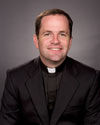The big picture about Confession
In the past week, on two different occasions, people have told me to post my answer to the common questions, “why do I need to go to a priest for Confession? Why can’t I just go to God directly?” In answering this, I ask you to take a step back with me and look at the big picture here. It starts with Adam and Eve, and what happened in the Garden of Eden. They committed Original Sin (the first mortal sin): they broke the relationship between God and man, lost their state of Original Grace, and the gates of Heaven were closed.
For thousands of years after that, God’s people tried to achieve union with God by making offerings, sacrifices, etc. for the forgiveness of sins. They were unable to do so; man could not achieve forgiveness of his serious sins on his own (and so, no one went to Heaven before Christ).
God became one of us in the person of Jesus Christ for the forgiveness of sins. He offered his life on the Cross as a sacrifice for us. “My blood …will be shed for you and for all so that sins may be forgiven”. Christ’s sacrifice on Mount Calvary becomes the only acceptable sacrifice to the Father for the forgiveness of sins. The gates of Heaven are re-opened, and salvation is offered to all who participate in Christ’s death and resurrection.
How do we participate in Christ’s death and resurrection? Primarily, through the sacraments. Christ has given us seven ways to receive his Sanctifying Grace which we need to get to Heaven. He has instituted Baptism, Eucharist, Confession, etc. through his priests. He gave them the power to baptize, celebrate the Eucharist, anoint the sick…and, he gave them the power to forgive sins (John 20:20-23): “Whose sins you forgive are forgiven them, and whose sins you retain are retained”.
Every time a priest celebrates a sacrament, he is acting in the person of Christ (in persona Christi). It is really Christ who is baptizing an infant, consecrating the Eucharist, etc. That is why we hear “this is my body” at Mass, and not “this is his body”. While we believe that transubstantiation takes place with the bread and wine, we also believe that it takes place with the priest. For example, it is no longer Fr. Greg celebrating Mass, even though it looks like me and sounds like me; it is Christ.
The same is true when we go to Confession. It is Christ in the confessional- hearing sins, offering counsel, and granting absolution. This is how we go to God directly, through the person of the priest, for the forgiveness of sins. We take our sins to the Cross, where they are wiped clean by the blood of Christ, and we receive Sanctifying Grace. If we had been in mortal sin (Confession is primarily for the forgiveness of mortal sins), we are one with God again. Just like we would turn to a priest to celebrate the Eucharist or the Anointing of the Sick, we turn to a priest for Reconciliation ... we turn to Christ.
For thousands of years after that, God’s people tried to achieve union with God by making offerings, sacrifices, etc. for the forgiveness of sins. They were unable to do so; man could not achieve forgiveness of his serious sins on his own (and so, no one went to Heaven before Christ).
God became one of us in the person of Jesus Christ for the forgiveness of sins. He offered his life on the Cross as a sacrifice for us. “My blood …will be shed for you and for all so that sins may be forgiven”. Christ’s sacrifice on Mount Calvary becomes the only acceptable sacrifice to the Father for the forgiveness of sins. The gates of Heaven are re-opened, and salvation is offered to all who participate in Christ’s death and resurrection.
How do we participate in Christ’s death and resurrection? Primarily, through the sacraments. Christ has given us seven ways to receive his Sanctifying Grace which we need to get to Heaven. He has instituted Baptism, Eucharist, Confession, etc. through his priests. He gave them the power to baptize, celebrate the Eucharist, anoint the sick…and, he gave them the power to forgive sins (John 20:20-23): “Whose sins you forgive are forgiven them, and whose sins you retain are retained”.
Every time a priest celebrates a sacrament, he is acting in the person of Christ (in persona Christi). It is really Christ who is baptizing an infant, consecrating the Eucharist, etc. That is why we hear “this is my body” at Mass, and not “this is his body”. While we believe that transubstantiation takes place with the bread and wine, we also believe that it takes place with the priest. For example, it is no longer Fr. Greg celebrating Mass, even though it looks like me and sounds like me; it is Christ.
The same is true when we go to Confession. It is Christ in the confessional- hearing sins, offering counsel, and granting absolution. This is how we go to God directly, through the person of the priest, for the forgiveness of sins. We take our sins to the Cross, where they are wiped clean by the blood of Christ, and we receive Sanctifying Grace. If we had been in mortal sin (Confession is primarily for the forgiveness of mortal sins), we are one with God again. Just like we would turn to a priest to celebrate the Eucharist or the Anointing of the Sick, we turn to a priest for Reconciliation ... we turn to Christ.


0 Comments:
Post a Comment
<< Home